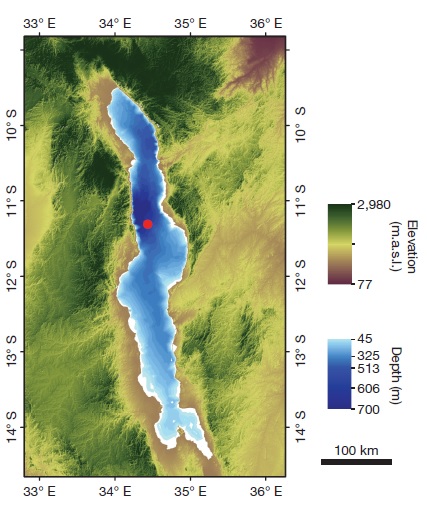NESSC-research: climate SE Africa increasingly wetter
The climate in southeastern Africa turned progressively more wet the past 1.3 million years, in contrast to the general idea that the African continent only became drier over time. This surprising discovery, based on a climate reconstruction from the area around Lake Malawi, was made by an international research team which included NESSC-researchers prof. Jaap Sinninghe Damsté and prof. Stefan Schouten. Their research was recently published in the science journal Nature.

The findings of the research are also of interest for theories about human evolution and migration of early humans in Africa. It has been generally assumed that the entire African continent became increasingly drier over time, which could have influenced the evolution of early humans. The new reconstruction shows that the climate in southeastern Africa experiences a wet and dry cycle every 100.000 years and that the region became increasingly wetter over the past 1.3 million years.
“Our results show that the story on human evolution is a little more complex than what was commonly thought”, says Tom Johnson, professor emeritus at the University of Minnesota Duluth (UMD), who led the project. “Our findings shed new light on the factual conditions in tropical East-Africa during the time that early man evolved, which makes them relevant for paleoanthropology.”
Lake Malawi
Already in 1994 Johnson began with the drilling project to collect core samples from the 700-meters deep Lake Malawi, one of the largest lakes in the world. Together with his fellow professors Erik Brown and Byron Steinman, Johnson formed an international research team with the necessary expertise, among them NESSC-researchers Jaap Sinninghe Damsté and Stefan Schouten at Utrecht University and NIOZ. Damsté and Schouten investigated how the temperature of the surface water changed over time. For this purpose, they used their TEX86 ‘paleothermometer’ which is based on the fossilized remains of membranes from specific bacteria.
Damsté: “It is fantastic to see how methods developed in my field can contribute to climate reconstructions, and in extension to other disciplines.”

Ten years of analysis
In 2005 the long awaited drilling took place and a 380-meters long core was collected from the bed of Lake Malawi. The analysis of the samples and determining the age of the different layers took over ten years of analysis. The much used method of carbon dating could only be applied to sediments younger than 50.000 years. However, the majority of the core samples was much older in age.
The researchers succeeded to date the oldest part of the core with the aid of volcanic ash-layers and by tracing reversals in magnetic polarity. The temperature history was traced back from changes in the distribution of organic compounds in unicellular organisms. In addition, the amount of rainfall over time was reconstructed using fossilized organic molecules from the waxy layer on plant leafs, to determine the variability in the deposition of calcium carbonate and vegetation over time.
Publication:
‘A progressively wetter climate in southern East Africa over the past 1.3 million years.’
Nature 2016. http://dx.doi.org/10.1038/nature19065
C. Johnson, J. P. Werne, E. T. Brown, A. Abbott, M. Berke, B. A. Steinman, J. Halbur, S. Contreras, S. Grosshuesch, A. Deino, R. P. Lyons, C. A. Scholz, S. Schouten & J. S. Sinninghe Damsté

